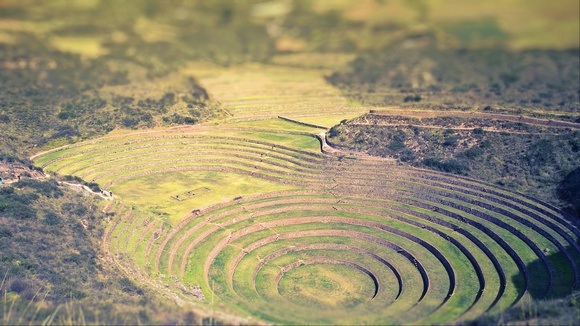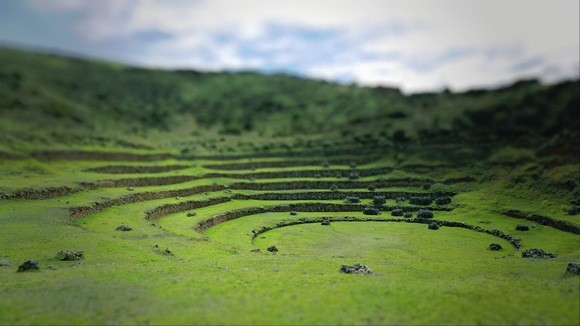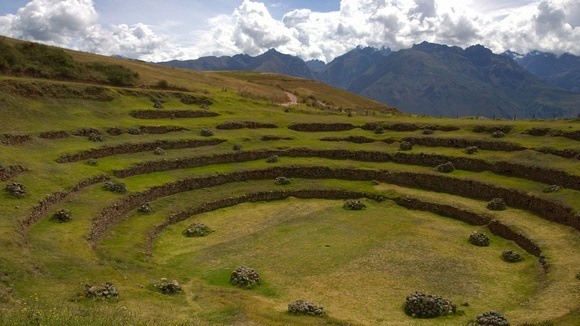Near Urubamba (about 50kms from Cusco in Peru), you drive up and up from the Sacred Valley floor to reach Moray: a collection of Inca ruins at about 3,500 metres above sea level. As with most of the cryptic Inca ruins, the method of construction and ultimate usage is highly interpretable.
This post was originally published in 2014. It has since been updated for accuracy of links and content.

Moray is a set of three circular depressions, the largest of which is about 30 metres deep. It is said to have been an agricultural laboratory for the Incas; each level of circular terrace models a different Andean growing environment, with temperature variations of up to 15 degrees (Celsius) between the top and bottom. The idea is that with these differences in temperature, wind, and orientation to the sun, the Incas used Moray to study the effects of different climates on crops.

But there could be more to this story.
It’s odd that Moray is so remotely located; why would the Incas build an agricultural lab so far away from Cusco and other urban centres? It’s not like Peru is lacking in the space to build something like Moray.
One school of thought suggests that Moray is considerably more extra-terrestrial than agricultural in its use. Apparently UFOs have been spotted in the area many times over the years, and similar to Machu Picchu, you can’t help but feel a certain other-worldly element to Moray.


There is another school of thought yet, that Moray was a place of Inca ceremonies and celebrations; modern-day shamans in the throes of plant medicine have seen Inca spirits processing and dancing on the terraces. And locals periodically host massive celebrations in Moray, with hundreds of dancers and performers lining each terrace; but again, that’s one helluva commute for an ancient celebration, especially during the Inca times when roads and cars didn’t exist.

The rock piles in the picture above don’t have any significance; they’re just left over from the latest round of restorations. But apparently a group of spiritual seekers visited this spot and thought that the rock piles were ancient burial grounds. They spent the afternoon doing ceremonies to honour and free these buried spirits.
Whether Moray is an agricultural lab, a place of celebration, or even a landing pad for “others” (who have been reputed to have helped to build these miraculously engineered marvels in Peru), we’ll never know. It’s easy to create the answers and uses that suit our agenda (like our darling dead-spirit-releasing disciples above). The truth…probably lies somewhere in between all the theories.
What do you think?



It looks a small playground or some kind of a gladiator thingy, I don’t know exactly. Good to know that there are wonders like this that it still around.
Hi Peter,
Ooh! A gladiator thingy. I like it! 🙂
Amazing picture! That closure experience is very cute!!!! – Thanks for sharing.
Thank you, Povonte!
Nora, with a 15 degree Celsius temperature difference between the top and the bottom it seems extremely likely to be an Incan agricultural testing station. Perfect for finding the best crops to grow on the terraces at different altitudes throughout the Incan territories. It is great to let the imagination roam randomly, but either way it is an astounding piece of engineering. Somewhere I would love to visit if I can find a low carbon way of travelling there fromm Europe.
Hi John,
Indeed, the agricultural testing ground theory holds strong. There’s just something that doesn’t quite add up when you take in all these near-miraculous ancient ruins….
As for a low carbon way to get here….slow boat it is! 😉
I believe they are landing pads for UFOs..thank you Nora for sharing.
When I was there, it struck me immediately as something other than for agricultural research. Seemed more like a landing pad than anything else. There is something about Peru that is puzzling, the Nazca lines, the Moray ruins and then the Inca culture itself. Perhaps everything is connected to shamanism and the use of ahayuasca at the time. What man has gained in knowledge may only be one drop of that contained in the ocean of the unknown.
Interesting… It’s kinda nice that, centuries later, with all our knowledge and modern technology, there are still mysteries we don’t know the answers to. Maybe the secrets of Moray are best left unanswered…
Ha ha – indeed! I think a little bit of mystery is a good thing for us…. 🙂
The Incas were doing science back in their day? They were far more complex than I ever figured them to be!
Penny,
The Incas were – in many ways – more technologically advanced than we are today. Their feats of engineering and knowledge of astrology continue to baffle modern-day scientists. They knew stuff….
BTW, Incas are famous for their extensive road networks and Moray is not remote at all (just look at a satellite image and you will see the site completely surrounded by towns and agricultural lands). Suggesting UFOs, even if it is just for fun, delegitimizes an already oppressed people.
Spending just a little effort to read serious archaeological accounts on the Inca will show how much we know about how they quarried, transported, shaped and stacked rocks. There is really no mysteries regarding the Inca among the scientists who study them.
I recommend reading “Mining and Quarrying in the Ancient Andes” as an introductory text to the topic.
In reply to the gentleman’s criticism above. There are many mysteries that the western mind is too closed to understand. I live here in the Sacred Valley and the history and current sightings of UFOs are very prevelant and known by many locals.
To the writer of the article. Excellent article.